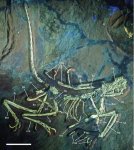- Joined
- Dec 3, 2017
- Messages
- 26,290
- Reaction score
- 16,771
- Gender
- Male
- Political Leaning
- Progressive
https://www.theguardian.com/science...en-forcing-a-radical-rethink-of-archaeopteryx
Have you heard? There is a new Archaeopteryx in town. Number 12, to be exact. Technically, this specimen has been around since 2010, but was only formally described three weeks ago, thereby making up for the tragic loss of the Haarlem specimen (now renamed as Ostromia crassipes) last year.
Archaeopteryx has since long formed a central piece in evolutionary debates. At the time of its discovery, it was the first Really Old Bird ever found. Moreover, its discovery in 1861 came just a few years after Darwin’s magnum opus On the Origin of Species, in which Darwin argued that one species could evolve into another. Archaeopteryx with its dapper mix of both reptilian and avian features was seen as a true transitional fossil, proving Darwin’s theory. Upon hearing of its discovery, in a letter from the Scottish palaeontologist Hugh Falconer dated 3 January 1863, Darwin replied to express his interest and excitement:
"I particularly wish to hear about the wondrous Bird; the case has delighted me, because no group is so isolated as Birds”
========================================================================================
The first specuimen of Archaeopteryx found was a single feather in so-called Jurassic lithographic limestone in soiuthern Germany. The first skeleton found would have been identified as the primitive dinosaur Compsognathus except for one feature: it had feathers of the same type & arrangement as found in modern birds. And it also had jaws full of spikey teeth & a long, bony tail, features found in dinosaurs but not found in modern birds.
While not on the main line of bird evolution from dinosaurs to modern birds, Archaeopteryx was also unique in terms of the structure of its feathers: the vanes on either side of the central shaft were asymmetric, a feature found only in modern birds that are capable of flight. One of the earliest birds known, Archaeopteryx indicates a transitional form between reptiles & birds.


Have you heard? There is a new Archaeopteryx in town. Number 12, to be exact. Technically, this specimen has been around since 2010, but was only formally described three weeks ago, thereby making up for the tragic loss of the Haarlem specimen (now renamed as Ostromia crassipes) last year.
Archaeopteryx has since long formed a central piece in evolutionary debates. At the time of its discovery, it was the first Really Old Bird ever found. Moreover, its discovery in 1861 came just a few years after Darwin’s magnum opus On the Origin of Species, in which Darwin argued that one species could evolve into another. Archaeopteryx with its dapper mix of both reptilian and avian features was seen as a true transitional fossil, proving Darwin’s theory. Upon hearing of its discovery, in a letter from the Scottish palaeontologist Hugh Falconer dated 3 January 1863, Darwin replied to express his interest and excitement:
"I particularly wish to hear about the wondrous Bird; the case has delighted me, because no group is so isolated as Birds”
========================================================================================
The first specuimen of Archaeopteryx found was a single feather in so-called Jurassic lithographic limestone in soiuthern Germany. The first skeleton found would have been identified as the primitive dinosaur Compsognathus except for one feature: it had feathers of the same type & arrangement as found in modern birds. And it also had jaws full of spikey teeth & a long, bony tail, features found in dinosaurs but not found in modern birds.
While not on the main line of bird evolution from dinosaurs to modern birds, Archaeopteryx was also unique in terms of the structure of its feathers: the vanes on either side of the central shaft were asymmetric, a feature found only in modern birds that are capable of flight. One of the earliest birds known, Archaeopteryx indicates a transitional form between reptiles & birds.


Last edited:

